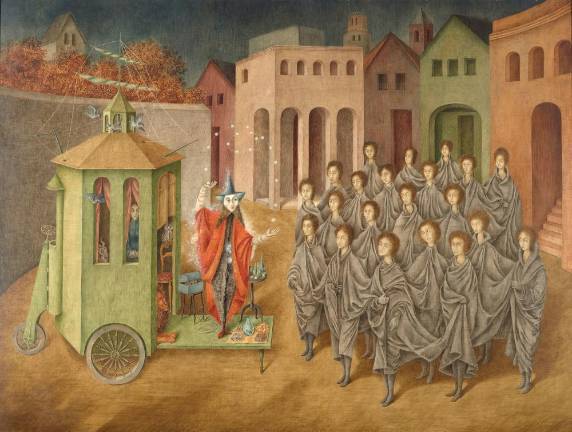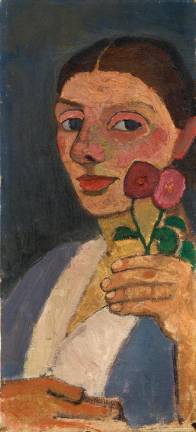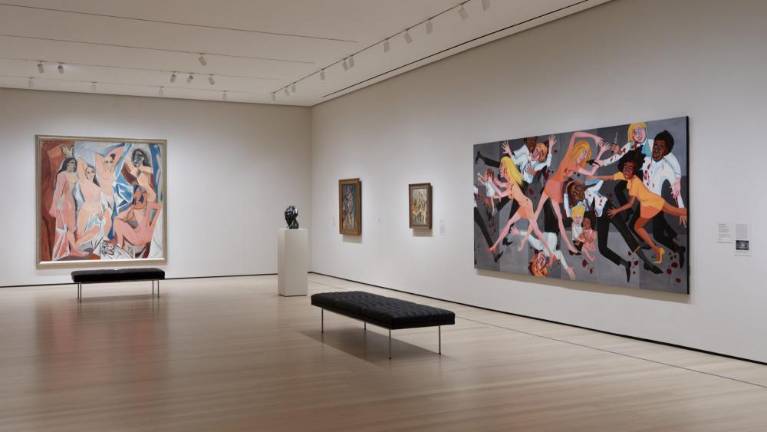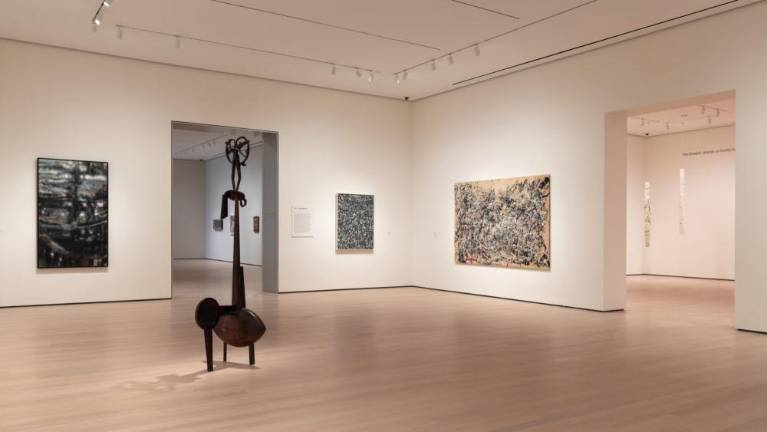Amidst all the blockbusters at the new MoMA, Mary Beth Edelson's "Some Living American Women Artists" a 1972 mixed media collage, could be overlooked, but it's extraordinary. Edelson, (now in her 80s and still making art) was a mid-century feminist, activist, gallerist, artist, and nonconformist of a high order. In "Some Living American Women Artists" she appropriated Leonardo da Vinci's "Last Supper," an icon of multiple kinds of power, and replaced all the figures with female artists – Georgia O'Keeffe taking the center seat at the table. Around the edges are names and snapshots of 82 other women artists. Any artwork that incorporates Alma Thomas, Yoko Ono, Agnes Martin, Alice Neel, Marisol, Helen Frankenthaler, and Yayoi Kusama was bound to rock my world.
Close to 50 years ago, Edelson, like all women artists of the time – and today – understood the unequal representation of women in museums and galleries, and made a statement about it. Now, in 2019, the Museum of Modern Art has lent its formidable voice to that chorus. One of the most outstanding changes at the museum, which reopened in October, is a noticeable increase in the number of women artists, artists of color, and non-Western artists presented. The stars of Cubism, Modernism, Abstract Expressionism and other isms were established long ago. Almost all were American or European men. But, there were plenty of women artists working alongside them, creating masterworks that have gone largely unnoticed.
Equal Billing and “Aha Moments”
Inspiration is a two-way transaction. "You have to see it to be it," says Sarah Suzuki, MoMA's curator who directed the opening of the new museum. She and the curatorial team placed at least twice as many works by women in the permanent collection galleries and two major solo exhibitions by women dominate the contemporary floor: "Handles" by Haegue Yang and Betye Saar's "Legends of Black Girl's Window."
But, Suzuki notes, it's not just about numbers. Faith Ringgold's "American People Series #20: Die" is a monumental painting from 1967 that now hangs adjacent to Pablo Picasso's 1907 "Les Demoiselles d’Avignon," one of the most visited works in the museum. "The impact of Faith Ringgold's painting in a Picasso gallery reverberates more that can be reflected in the idea that it's one work by a female artist," she says. Suzuki is also the curatorial leader for MoMA's "Modern Women's Fund," founded by philanthropist Sarah Peter. Its mission, she explains, is "to think about how to improve the lives of women that work at the museum and better celebrate the achievements of women across everything we do here."
Marcel Duchamp Had a Sister!
Whether the discovery of Suzanne Duchamp, who worked in the shadow of her brother, Marcel Duchamp, or the chance to consider Lee Krasner's work hanging next to a painting by her husband, Jackson Pollock, or noticing the harmonies between Louise Bourgeois' "Sleeping Figure" and Wifredo Lam's "The Jungle," the galleries are filled with "aha" moments. My whole sense of Surrealism was redefined by women like Remedios Vara, Kay Sage and Leonora Carrington, and their non-threatening dream worlds.
Suzuki hopes visitors will find surprising treasures in every gallery, and mentions a trio of sculptures. "It's in a gallery called 'From Soup Cans to Flying Saucers' that's circling around Pop Art ... So there are artists who were using the materials of the world around them - all those mass media sources, and this kind of sense of what city culture and visual culture looked like at the moment. There's a stack of three small acrylic cubes made by the artist Idelle Weber," Suzuki notes.
"Each of the sides of this clear acrylic cube is screen printed with the silhouette of this kind of classic 1960s ad man. So, there are guys in suits kind of comfortably slouching, gesticulating to their cohorts. It's like looking into a window, in a way, because of the transparency. Every side of the cube has a different image, so you get the sense of layering that's really incredible. Idelle Weber, I'm sure, was the visual reference for the opening credits of 'Mad Men,' and I don't think she's ever been credited for that. But this is the work of a woman who, in the 1960s, is totally critiquing that kind of macho, ad man, businessman, boardroom culture in a way that's wildly appealing and super engaging. I'm absolutely delighted that they are they are side-by-side with the Warhol 'Soup Cans' and the Lichtenstein 'Drowning Girl.'"
Much More to Come
Every six months MoMA's permanent collection will rotate, providing endless opportunities to see more work by women artists. Says Suzuki, "The makeup of the curatorial body here is predominantly women, and there's a sense of having the galleries reflect who we are. There's an idea that the institution is a voice from on high. It's not. Every one of those galleries, every one of those acquisitions comes from the passion and interest of one curator who was able to spark an interest in their colleagues in a way that almost kind of catches fire and gains traction. What you see is a way for us to try to live who we are as curators, and exhibition makers, and catalogers, and collection specialists. It feels great to be in those galleries with the women who came before, and helped to pave the way for artists today and for all of us who work in this field."
When I was a girl, MoMA's lobby was dominated by Joan Miró's bronze "Moonbird" and Jackson Pollock's massive, "One: Number 31, 1950." I loved visiting the museum, in part because I was so proud that a woman's artwork held court equal to a man's. Some years later I learned that Joan is the Catalan spelling of John, and Miró was a man. Today's girls and women, and those for years to come, will find all kinds of inspiration thanks to Suzuki and her MoMA colleagues and all the women artists who were putting their vision, passion and work out there, even before anyone was paying attention. You have to see it to be it.
IF YOU GO
What: More Women's Art at MoMA
Where: The Museum of Modern Art, 11 West 53rd St.
When: Through spring 2020 and beyond



